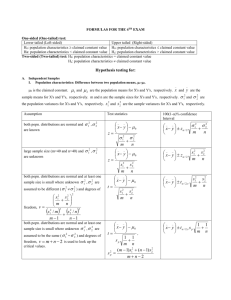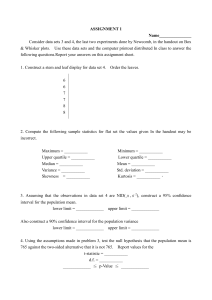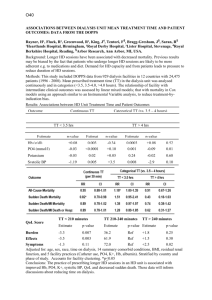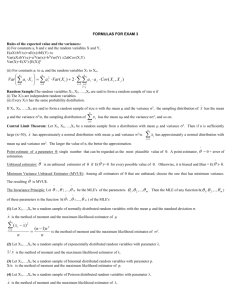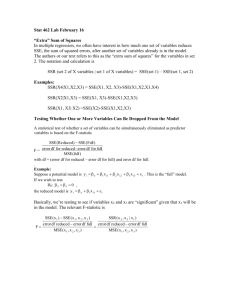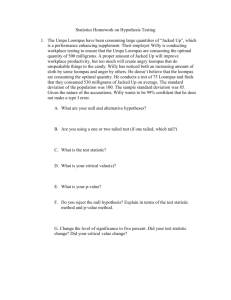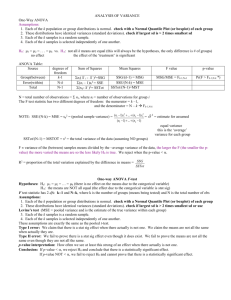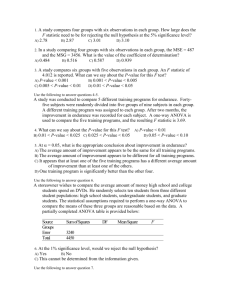these formulas
advertisement
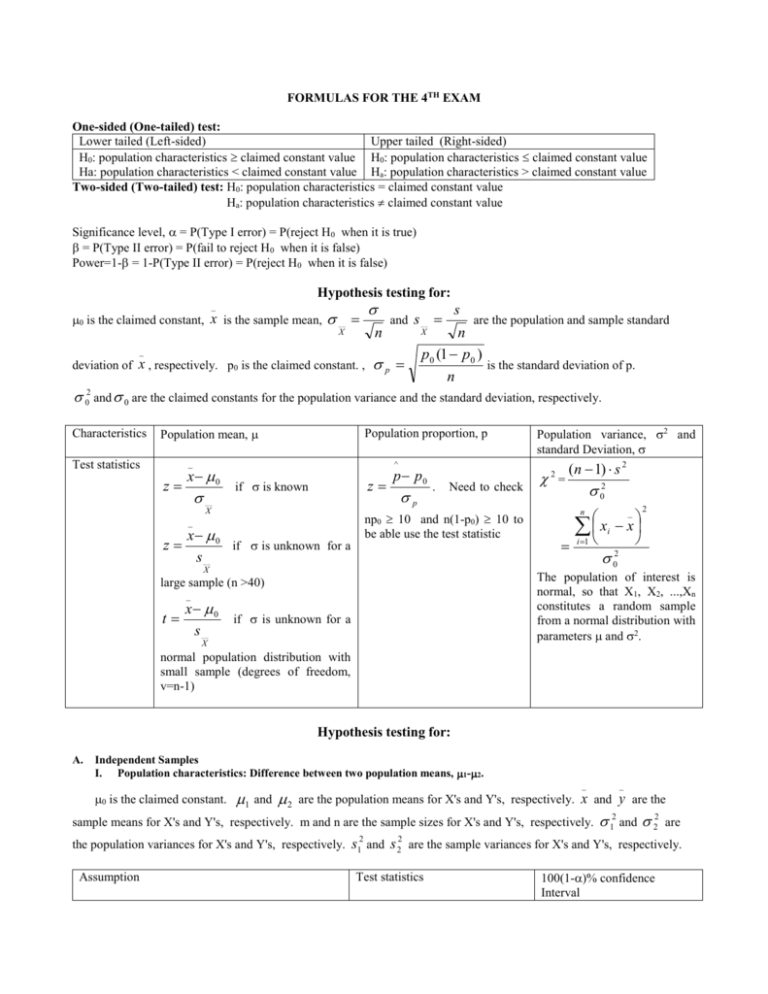
FORMULAS FOR THE 4TH EXAM One-sided (One-tailed) test: Lower tailed (Left-sided) Upper tailed (Right-sided) H0: population characteristics claimed constant value H0: population characteristics claimed constant value Ha: population characteristics < claimed constant value Ha: population characteristics > claimed constant value Two-sided (Two-tailed) test: H0: population characteristics = claimed constant value Ha: population characteristics claimed constant value Significance level, = P(Type I error) = P(reject H0 when it is true) = P(Type II error) = P(fail to reject H0 when it is false) Power=1- = 1-P(Type II error) = P(reject H0 when it is false) Hypothesis testing for: _ 0 is the claimed constant, x is the sample mean, __ and n X _ deviation of x , respectively. p0 is the claimed constant. , s s __ are the population and sample standard n p0 (1 p0 ) is the standard deviation of p. n X p 02 and 0 are the claimed constants for the population variance and the standard deviation, respectively. Characteristics Population mean, Test statistics Population proportion, p _ z x 0 ^ z if is known __ X p . Need to check np0 10 and n(1-p0) 10 to be able use the test statistic _ z p p0 x 0 if is unknown for a s __ Population variance, 2 and standard Deviation, 2= (n 1) s 2 02 _ x x i i 1 2 n 2 0 X The population of interest is normal, so that X1, X2, ...,Xn constitutes a random sample from a normal distribution with parameters and 2. large sample (n >40) _ x 0 t if is unknown for a s __ X normal population distribution with small sample (degrees of freedom, v=n-1) Hypothesis testing for: A. Independent Samples I. Population characteristics: Difference between two population means, 1-2. 0 is the claimed constant. 1 and 2 _ sample means for X's and Y's, respectively. m and n are the sample sizes for X's and Y's, respectively. the population variances for X's and Y's, respectively. Assumption _ are the population means for X's and Y's, respectively. x and 2 1 y are the 12 and 22 2 2 are s and s are the sample variances for X's and Y's, respectively. Test statistics 100(1-)% confidence Interval both popn. distributions are normal and are known 12 , 22 _ _ x y 0 z 12 m large sample size (m>40 and n>40) and are unknown , 2 1 2 2 sample size is small where unknown 12 , 22 are assumed to be different ( 1 2 ) and degrees of 2 2 2 s12 s 22 m n freedom, v 2 2 s12 / m s2 / n 2 m 1 n 1 n s12 s 22 _ _ x y z /2 m n _ _ x y 0 , t 1 1 sp m n (m 1) s12 (n 1) s 22 s 2p mn2 1 1 _ _ x y t / 2 ;v s p m n _ s2 s2 _ _ x y t / 2 ; v 1 2 m n both popn. distributions are normal and at least one sample size is small where unknown , 2 1 2 2 are assumed to be the same ( = ) and degrees of 2 1 2 2 freedom, v m n 2 is used to look up the critical values. II. 22 x y 0 z 2 s1 s 22 m n _ _ x y 0 t 2 s1 s 22 m n _ both popn. distributions are normal and at least one 12 22 _ _ x y z / 2 m n Population characteristics: Difference between two population proportions, p1-p2. ^ ^ p0 is the claimed constant. p 1 and p 2 are the sample proportions for X's and Y's, respectively. p1 and p 2 are the population proportions for X's and Y's, respectively. m and n are the large sample sizes for X's and Y's, respectively. The ^ estimator for p is p Test statistics: z X Y m ^ n ^ p1 p2 mn mn mn ^ ^ p1 p 2 p0 , ^ ^ 1 1 p1 p m n ^ ^ 100(1-)% large sample confidence Interval: p1 p 2 z / 2 ^ ^ ^ ^ p1 1 p1 p 2 1 p 2 m n 12 / 22 or standard deviations, 1 / 2 . 12 and 22 are the population variances for X's and Y's, III. Population characteristics: Ratio of the two population variances, X and Y's are random sample from a normal distribution. 2 respectively. s1 and Y's, respectively. s 22 are the sample variances for X's and Y's, respectively. m and n are the sample sizes for X's and s12 / s 22 12 s12 / s 22 s12 2 2 Test statistics: F 2 . 100(1-)% confidence Interval for 1 / 2 : F / 2;m 1,n 1 22 F1 / 2;m 1,n 1 s2 B. Dependent Samples- Paired Data Population characteristics: Difference between two population means, D =1-2. 0 is the claimed constant. Assumption: the difference distribution should be normal. _ Test statistics: t d 0 sD / n _ where D=X-Y and d and s D are the corresponding sample average and the standard deviation of D. Both X and Y must have n observations. The degrees of freedom to look at the table is v=n-1 _ sD 100(1-)% confidence Intervals with the same assumptions: d t / 2;n 1 n Decision can be made in one of the two ways in Parts I, II, and III for single population characteristics or the comparing two poulations: a. Let z* or t* be the computed test statistic values. if test statistics is z if test statistics is t Lower tailed test P-value = P(z<z*) P-value = P(t<t*) Upper tailed test P-value = P(z>z*) P-value = P(t>t*) Two-tailed test P-value = 2P(z>|z*|) P-value = 2P(t > |t*| ) In each case, you can reject H0 if P-value and fail to reject H0 (accept H0) if P-value > b. Rejection region for level test: test statistics is z test statistics is t test statistics is 2 test statistics is F Lower tailed test z -z t -t;v 2 < 12 ;n1 F F1-;m-1,n-1 Upper tailed test z z t t;v 2 > 2;n1 F F;m-1,n-1 Two- tailed test z -z/2 or z z/2 t -t/2;v or t t/2;v 2 < 12 / 2;n1 or 2 > 2 / 2;n1 F F1-/2;m-1,n-1 or F F/2;m-1,n-1 Do not forget that, F1-/2;m-1,n-1 = 1 / F/2;n-1,m-1 for the F-table Single Factor ANOVA : Model: X ij i ij treatment). X ij : observations , or X ij i ij i : ith treatment mean, where i=1,...,I (number of treatments), j=1,...,J (number of observations in each i i : ith treatment effect. ij : errors which are normally distributed with mean, 0 and the constant variance, 2 . Assumptions: X ij 's are independent ( ij 's are independent). ij 's are normally distributed with mean, 0 and the constant variance, 2 . X ij 's are normally distributed with mean, i Hypothesis: Or H 0 : 1 ... I 1 I H0 :i 0 for all i versus versus and the constant variance, 2. H a : at least one i j for i j where i .and j 's are treatment means. H a : i 0 for at least one i where i is the ith treatment effect. Analysis of Variance Table: Source df SS MS F Prob > F Treatments I-1 SSTr MSTr = SStr / (I-1) MSTr / MSE P-value Error I(J-1) SSE MSE = SSE / [I(J-1)] Total IJ-1 SSTotal where df is the degrees of freedom, SS is the sum of squares, MS is the mean square. Reject H 0 if the P-value or if the test statistics F > F;I-1,I(J-1). If you reject the null hypothesis, you need to use multiple comparison test such as Tukey-Kramer I For the case of unequal sample sizes, let n Ji and j=1,…,Ji . Then the difference in the analysis of variance table and multiple i 1 comparison test is as follows. Source Treatments Error Total Df I-1 n-I n-1 SS SSTr SSE SSTotal MS MSTr = SStr / (I-1) MSE = SSE / (n-I) F MSTr / MSE Prob > F P-value where df is the degrees of freedom, SS is the sum of squares, MS is the mean square. Reject H 0 if the P-value or if the test statistics F > F;I-1,n-I. If you reject the null hypothesis, you need to use multiple comparison test such as Tukey-Kramer to see which means are different. Confidence Interval for ci i : c MSE ci2 _ i x i t / 2; I ( J 1) J i i Simple Linear Regression and Correlation PEARSON’S CORRELATION COEFFICIENT :measures the strength & direction of the linear relationship between X and Y. X and Y must be numerical variables, r X i X Yi Y (n 1) s x s y X X Y Y X X Y Y i i 2 2 i i where sx and sy are the standard deviations for x and y. Notice we are looking at how far each point deviates from the average X and Y value. H 0 : XY 0 (the true correlation is zero) versus The formal test for the correlation has the test statistics H a : XY 0 t r n2 1 r2 (the true correlation is not zero). with n-2 degrees of freedom. Minitab gives you the following output for simple linear regression: parameters 0 and Predictor (y) Y 0 1 x e , where n observations included, the 1 are constants whose "true" values are unknown and must be estimated from the data. Coef SE Coef T Constant b0 sb0 b0 s b0 p-value for Ha : 0 0 Independent(x) b1 s b1 b1 s b1 p-value for H a : 1 0 Analysis of Variance Source DF Regression Residual Error Total SS P MS F 1 SSR MSR=SSR/1 MSR/MSE n-2 n-1 SSE SST MSE=SSE/(n-2) P p-value for H a : 1 0 Coefficient of Determination, R2 : Measure what percent of Y's variation is explained by the X variables via the regression model. It tells us the proportion of SST that is explained by the fitted equation. Note that SSE is the proportion of SST that is not explained by the model. SSR SSE 1 . SST SST H 0 : 1 10 R2 Only in simple linear regression, R 2 r 2 where r is the Pearson’s correlation coefficient. H a : 1 10 Test statistics: t b1 10 s b1 where 10 is the value slope is compared with. Decision making can be done by using error degrees of freedom for any other t test we have discussed before (either using the P-value or the rejection region method). The 100(1-)% confidence interval for 1 is b1 t / 2;df sb 1
